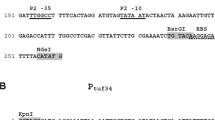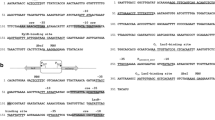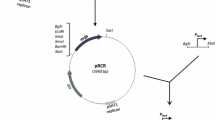Abstract
Lactobacillus species are attractive hosts for the expression of heterologous proteins, antigens, vaccines, and drugs due to their GRAS (generally recognized as safe) status. The bioengineering techniques open new possibilities of improving Lactobacillus strains. In this regard, the control of the gene expression in Lactobacillus strains through the adequate native or engineered promoters acquires a key role in the development of biotechnological applications and for their function as probiotic bacteria. Depending on the objective sought, the protein produced and the strain used, inducible or constitutive promoters can be chosen. Whereas, when a fine-tuning of gene expression is required, the development of synthetic promoter libraries could be the best approach. In this work, we revise the main constitutive and inducible natural promoters from Lactobacillus strains or from other genus that have been applied in Lactobacillus, as well as the few engineered promoters developed for these bacteria.

Similar content being viewed by others
References
Alcántara C, Sarmiento-Rubiano LA, Monedero V, Deutscher J, Pérez-Martínez G, Yebra MJ (2008) Regulation of Lactobacillus casei sorbitol utilization genes requires DNA-binding transcriptional activator GutR and the conserved protein GutM. Appl Environ Microbiol 74(18):5731–5740
Allain T, Mansour NM, Bahr MMA, Martín R, Florent I, Langella P, Bermúdez-Humarán LG (2016) A new lactobacilli in vivo expression system for the production and delivery of heterologous proteins at mucosal surfaces. FEMS Microbiol Lett 363:fnw117
Alvarez-Sieiro P, Martín MC, Redruello B, del Rio B, Ladero V, Palanski BA, Khosla C, Fernández M, Alvarez MA (2014) Generation of food-grade recombinant Lactobacillus casei delivering Myxococcus xanthus prolyl endopeptidase. Appl Microbiol Biotechnol 98(15):6689–6700
Anbazhagan K, Sasikumar P, Gomathi S, Priya HP, Selvam GS (2013) In vitro degradation of oxalate by recombinant Lactobacillus plantarum expressing heterologous oxalate decarboxylase. J Appl Microbiol 115(3):880–887
Arsenijevic S, Topisirovic L (2000) Molecular analysis of mutated Lactobacillus acidophilus promoter-like sequence P15. Can J Microbiol 46:938–945
Baek SJ, Jung KH, Hoon Kim H, Kim SF (1997) Expression and secretion of carboxymethyl cellulase in Bacillus subtilis by Lactobacillus casei lactate dehydrogenase gene promoter. Biotechnol Lett 19:27–29
Binishofer B, Moll I, Henrich B, Bläsi U (2002) Inducible promoter-repressor system from the Lactobacillus casei phage φFSW. Appl Environ Microbiol 68(8):4132–4135
Blazeck J, Alper HS (2013) Promoter engineering: recent advances in controlling transcription at the most fundamental level. Biotechnol J 8(1):46–58
Böhmer N, König S, Fischer L (2013) A novel manganese starvation-inducible expression system for Lactobacillus plantarum. FEMS Microbiol Lett 342(1):37–44
Bosma EF, Forster J, Nielsen AT (2017) Lactobacilli and pediococci as versatile cell factories – evaluation of strain properties and genetic tools. Biotechnol Adv 35(4):419–442
Bron PA, Hoffer SM, Van Swam II, De Vos WM, Kleerebezem M (2004) Selection and characterization of conditionally active promoters in Lactobacillus plantarum, using alanine racemase as a promoter probe. Appl Environ Microbiol 70(1):310–317
Chen YS, Steele JL (2005) Analysis of promoter sequences from Lactobacillus helveticus CNRZ32 and their activity in other lactic acid bacteria. J Appl Microbiol 98(1):64–72
Chen Y, Qi M, Xu M, Huan H, Shao W, Yang Y (2018) Food-grade gene transformation system constructed in Lactobacillus plantarum using a GlmS-encoding selection marker. FEMS Microbiol Lett 365(21):fny254
Derzelle S, Hallet B, Ferain T, Delcour J, Hols P (2002) Cold shock induction of the cspL gene in Lactobacillus plantarum involves transcriptional regulation. J Bacteriol 184(19):5518–5523
Duong T, Miller MJ, Barrangou R, Azcarate-Peril MA, Klaenhammer TR (2010) Construction of vectors for inducible and constitutive gene expression in Lactobacillus. Microb Biotechnol 4(3):357–367
Gold RS, Meagher MM, Tong S, Hutkins RW, Conway T (1996) Cloning and expression of the Zymomonas mobilis “production of ethanol” genes in Lactobacillus casei. Curr Microbiol 33:256–260
Gosalbes MJ, Esteban CD, Galán JL, Pérez-Martínez G (2000) Integrative food-grade expression system based on the lactose regulon of Lactobacillus casei. Appl Environ Microbiol 66(11):4822–4828
Guinane CM, Piper C, Draper LA, O’Connor PM, Hill C, Ross RP, Cotter PD (2015) Impact of environmental factors on bacteriocin promoter activity in gut derived Lactobacillus salivarius. Appl Environ Microbiol 81(22):7851–7859
Heiss S, Hörmann A, Tauer C, Sonnleitner M, Egger E, Grabherr R, Heinl S (2016) Evaluation of novel inducible promoter/repressor systems for recombinant protein expression in Lactobacillus plantarum. Microb Cell Factories 15:50
Hertel C, Schmidt G, Fisher M, Oellers K, Hammes WP (1998) Oxygen-dependent regulation of the expression of the catalase gene katA of Lactobacillus sakei LTH677. Appl Environ Microbiol 64(4):1359–1365
Hols P, Ferain T, Garmyn D, Bernard N, Delcour J (1994) Use of homologous expression-secretion signals and vector-free stable chromosomal integration in engineering of Lactobacillus plantarum for α-amylase and levanase expression. Appl Environ Microbiol 60(5):1401–1413
Hols P, Slos P, Dutot P, Reymund J, Chabot P, Delplace B, Delcour J, Mercenier A (1997) Efficient secretion of the model antigen M6-gp41E in Lactobacillus plantarum NCIMB 8826. Microbiol 143(8):2733–2741
Jensen PR, Hammer K (1998a) Artificial promoters for metabolic optimization. Biotechnol Bioeng 58(2–3):191–195
Jensen PR, Hammer K (1998b) The sequence of spacers between the consensus sequences modulates the strength of prokaryotic promoters. Appl Environ Microbiol 64(1):82–87
Kahala M, Palva A (1999) The expression signals of the Lactobacillus brevis slpA gene direct efficient heterologous protein production in lactic acid bacteria. Appl Microbiol Biotechnol 51(1):71–78
Kajikawa A, Ichikawa E, Igimi S (2010) Development of a highly efficient protein-secreting system in recombinant Lactobacillus casei. J Microbiol Biotechnol 20(2):375–382
Kerovuo J, Tynkkynen S (2000) Expression of Bacillus subtilis phytase in Lactobacillus plantarum 755. Lett Appl Microbiol 30(4):325–329
Kiatpapan P, Yamashita M, Kawaraichi N, Yasuda T, Murooka Y (2001) Heterologous expression of a gene encoding cholesterol oxidase in probiotic strains of Lactobacillus plantarum and Propionibacterium freudenreichii under the control of native promoters. J Biosci Bioeng 92(5):459–465
Klein JR, Schmidt U, Plapp R (1994) Cloning, heterologous expression, and sequencing of a novel proline iminopeptidase gene, pepl, from Lactobacillus delbrueckii subsp. lactis DSM 7290. Microbiol 140(5):1133–1139
Kolandaswamy A, George L, Sadasivam S (2009) Heterologous expression of oxalate decarboxylase in Lactobacillus plantarum NC8. Curr Microbiol 58(2):117–121
Krüger S, Hecker M (1995) Regulation of the putative bglPH operon for aryl-b-glucoside utilization in Bacillus subtilis. J Bacteriol 177(19):5590–5597
Krüger C, Hultberg A, van Dollenweerd C, Marcotte H, Hammarström L (2005) Passive immunization by lactobacilli expressing single-chain antibodies against Streptococcus mutans. Mol Biotechnol 31(3):221–230
Landete JM, García-Haro L, Blasco A, Manzanares P, Berbegal C, Monedero V, Zúñiga M (2010) Requirement of the Lactobacillus casei MaeKR two-component system for L-malic acid utilization via a malic enzyme pathway. Appl Environ Microbiol 76(1):84–95
Landete JM, Langa S, Revilla C, Margolles A, Medina M, Arqués JL (2015) Use of anaerobic green fluorescent protein versus green fluorescent protein as reporter in lactic acid bacteria. Appl Microbiol Biotechnol 99(16):6865–6877
Landete JM, Peirotén A, Margarita M, Arqués JL (2017) Labeling Listeria with anaerobic fluorescent protein for food safety studies. J Dairy Sci 100(1):113–117
Leroy F, Vuyst L (2004) Lactic acid bacteria as functional starter cultures for the food fermentation industry. Trends Food Sci Technol 15(2):67–78
Liu J-R, Yu B, Liy F-H, Cheng K-J, Zhao X (2005) Expression of rumen microbial fibrolytic enzyme genes in probiotic Lactobacillus reuteri. Appl Environ Microbiol 71(11):6769–6775
Maldonado A, Ruiz-Barba JL, Jiménez-Díaz R (2003) Purification and genetic characterization of plantaricin NC8, a novel coculture-inducible two-peptide bacteriocin from Lactobacillus plantarum NC8. Appl Environ Microbiol 69(1):383–389
Maldonado A, Jiménez-Díaz R, Ruiz-Barba JL (2004) Induction of plantaricin production in Lactobacillus plantarum NC8 after coculture with specific Gram-positive bacteria is mediated by an autoinduction mechanism. J Bacteriol 186(5):1556–1564
Martínez-Fernández JA, Bravo A, Peirotén A, Arqués JL, Landete JM (2019) Bile-induced promoters for gene expression in Lactobacillus strains. Appl Microbiol Biotechnol 103:3819–3827
Matern HT, Klein JR, Henrich B, Plapp BR (1994) Determination and comparison of Lactobacillus delbrueckii ssp. lactis DSM7290 promoter sequences. FEMS Microbiol Lett 122(1–2):121–128
Mathiesen G, Namløs HM, Risøen PA, Axelsson L, Eijsink VGH (2004) Use of bacteriocin promoters for gene expression in Lactobacillus plantarum C11. J Appl Microbiol 96(4):819–827
Mayo B, Derzelle S, Fernández M, Léonard C, Ferain T, Hols P, Suárez JE, Delcour J (1997) Cloning and characterization of cspL and cspP, two cold-inducible genes from Lactobacillus plantarum. J Bacteriol 179(9):3039–3042
McCracken A, Timms P (1999) Efficiency of transcription from promoter sequence variants in Lactobacillus is both strain and context dependent. J Bacteriol 181(20):6569–6572
McCracken A, Turner MS, Giffard P, Hafner LM, Timms P (2000) Analysis of promoter sequences from Lactobacillus and Lactococcus and their activity in several Lactobacillus species. Arch Microbiol 173:383–389
Miwa Y, Nakata A, Ogiwara A, Yamamoto M, Fujita Y (2000) Evaluation and characterization of catabolite-responsive elements (cre) of Bacillus subtilis. Nucleic Acids Res 28(5):1206–1210
Monedero V, Yebra MJ, Poncet S, Deutscher J (2008) Maltose transport in Lactobacillus casei and its regulation by inducer exclusion. Res Microbiol 159(2):94–102
Muscariello L, Marasco R, De Felice M, Sacco M (2001) The functional ccpA gene is required for carbon catabolite repression in Lactobacillus plantarum. Appl Environ Microbiol 67(7):2903–2907
Nguyen TT, Mathiesen N, Fredriksen L, Kitt R, Nguyen TH, Eijsink VGH, Dietmar Haltrich D, Peterbauer CK (2011) A food-grade system for inducible gene expression in Lactobacillus plantarum using an alanine racemase-encoding selection marker. J Agric Food Chem 59(10):5617–5624
Nguyen TT, Nguyen HM, Geiger B, Mathiesen G, Eijsink VGH, Peterbauer CK, Haltrich D, Nguyen TH (2015) Heterologous expression of a recombinant lactobacillal β-galactosidase in Lactobacillus plantarum: effect of different parameters on the sakacin P-based expression system. Microb Cell Factories 14:30
Nguyen H, Pham M, Stelzer EM, Plattner E, Grabherr R, Mathiesen G, Peterbauer CK, Haltrich D, Nguyen TH (2019) Constitutive expression and cell-surface display of a bacterial β-mannanase in Lactobacillus plantarum. Microb Cell Factories 18:76
Pfeiler EA, Azcárate-Peril MA, Klaenhammer TR (2007) Characterization of a novel bile-inducible operon encoding a two-component regulatory system in Lactobacillus acidophilus. J Bacteriol 189(13):4624–4634
Pouwels PH, Leer RJ (1993) Genetics of lactobacilli: plasmids and gene expression. Antonie Van Leeuwenhoek 64(2):85–107
Ross W, Gosink K, Salomon J, Igarashi K, Zhou C, Ishihama A, Severinov K, Gourse R (1993) A third recognition element in bacterial promoters: DNA binding by the a subunit of RNA polymerase. Science 262(5138):1407–1413
Rud I, Jensen PR, Naterstad K, Axelsson L (2006) A synthetic promoter library for constitutive gene expression in Lactobacillus plantarum. Microbiol 152(4):1011–1019
Rush C, Hafner L, Timms P (1997) Protein A as a fusion partner for the expression of heterologous proteins in Lactobacillus. Appl Microbiol Biotechnol 47(5):537–542
Saarela M, Mogensen G, Fonden R, Mättö J, Mattila-Sandholm T (2000) Probiotic bacteria: safety, functional and technological properties. J Biotechnol 84(3):197–215
Salis HM, Mirsky EA, Voigt CA (2009) Automated design of synthetic ribosome binding sites to control protein expression. Nat Biotechnol 27(10):946–950
Scheirlinck T, Mahillon J, Joos H, Dahese P, Michiels F (1989) Integration and expression of a-amylase and endoglucanase genes in the Lactobacillus plantarum chromosome. Appl Environ Microbiol 55:2130–2137
Schmidt G, Hertel C, Hammes WP (1999) Molecular characterisation of the dnaK operon of Lactobacillus sakei LTH681. Syst Appl Microbiol 22(3):321–328
Serrano LM, Molenaar D, Wels M, Teusink B, Bron PA, de Vos WM, Smid EJ (2007) Thioredoxin reductase is a key factor in the oxidative stress response of Lactobacillus plantarum WCFS1. Microbial Cell Fact 6:29
Sheehan VM, Sleator RD, Fitzgerald GF, Hill C (2006) Heterologous expression of BetL, a betaine uptake system, enhances the stress tolerance of Lactobacillus salivarius UCC118. Appl Environ Microbiol 72(3):2170–2177
Song X, Huang HE, Xiong Z, Ai L, Yang S (2017) CRISPR-Cas9D10A nickase-assisted genome editing in Lactobacillus casei. Appl Environ Microbiol 83(22):e01259–e01217
Sørvig E, Mathiesen G, Eijsink VGH, Axelsson L, Grönqvist S, Naterstad K (2003) Construction of vectors for inducible gene expression in Lactobacillus sakei and L. plantarum. FEMS Microbiol Lett 229:119–126
Sørvig E, Mathiesen G, Naterstad K, Eijsink VG, Axelsson L (2005) High-level, inducible gene expression in Lactobacillus sakei and Lactobacillus plantarum using versatile expression vectors. Microbiol 151:2439–2449
Tauer C, Heinl S, Egger E, Heiss S, Grabherr R (2014) Tuning constitutive recombinant gene expression in Lactobacillus plantarum. Microb Cell Factories 13:150
Terpe K (2006) Overview of bacterial expression systems for heterologous protein production: from molecular and biochemical fundamentals to commercial systems. Appl Microbiol Biotechnol 72(2):211–222
Voskuil MI, Chambliss GH (1998) The −16 region of Bacillus subtilis and other Gram-positive bacterial promoters. Nucleic Acids Res 26(15):3584–3590
Wiernasz N, Cornet J, Cardinal M, Pilet MF, Passerini D, Leroi F (2017) Lactic acid bacteria selection for biopreservation as a part of hurdle technology approach applied on seafood. Front Mar Sci 4:119
Wu C-M, Lin C-F, Chang Y-C, Chung T-C (2006) Construction and characterization of nisin-controlled expression vectors for use in Lactobacillus reuteri. Biosci Biotechnol Biochem 70(4):757–767
Xiong Z-Q, Qiao-Hui Wang Q-H, Ling-Hui Kong L-H (2017) Improving the activity of bile salt hydrolases in Lactobacillus casei based on in silico molecular docking and heterologous expression. J Dairy Sci 100(2):975–980
Yebra MJ, Zúñiga M, Beaufils S, Pérez-Martínez G, Deutscher J, Monedero V (2007) Identification of a gene cluster enabling Lactobacillus casei BL23 to utilize myo-inositol. Appl Environ Microbiol 73(12):3850–3858
Yigang XU, Yijing LI (2008) Construction of recombinant Lactobacillus casei efficiently surface displayed and secreted porcine parvovirus VP2 protein and comparison of the immune responses induced by oral immunization. Immunol 124(1):68–75
Zeng Z, Yu R, Zuo F, Zhang B, Peng D, Ma H, Chen S (2016) Heterologous expression and delivery of biologically active exendin-4 by Lactobacillus paracasei L14. PLoS One 11(10):e0165130
Zhang S, Xu Z, Qin L, Kong J (2019) Development of strong lactose/galactose-inducible expression system for Lactobacillus plantarum by optimizing promoter. Biochem Eng J 151:107316
Zhao H, Yuan L, Hu K, Liu L, Peng S, Li H, Wang H (2019) Heterologous expression of ctsR from Oenococcus oeni enhances the acid-ethanol resistance of Lactobacillus plantarum. FEMS Microbiol Lett 366:fnz192
Zúñiga M, Champomier-Verges M, Zagorec M, Pérez-Martínez G (1998) Structural and functional analysis of the gene cluster encoding the enzymes of the arginine deiminase pathway of Lactobacillus sake. J Bacteriol 180(6):4154–4159
Funding
This work was supported by project RTA2017-00002-00-00 from the Spanish Ministry of Economy and Competitiveness.
Author information
Authors and Affiliations
Corresponding author
Ethics declarations
Conflict of interest
The authors declare that they have no conflict of interest.
Ethical statement
This article does not contain any studies with human participants or animals performed by any of the authors.
Additional information
Publisher’s note
Springer Nature remains neutral with regard to jurisdictional claims in published maps and institutional affiliations.
Rights and permissions
About this article
Cite this article
Peirotén, Á., Landete, J.M. Natural and engineered promoters for gene expression in Lactobacillus species. Appl Microbiol Biotechnol 104, 3797–3805 (2020). https://doi.org/10.1007/s00253-020-10426-0
Received:
Revised:
Accepted:
Published:
Issue Date:
DOI: https://doi.org/10.1007/s00253-020-10426-0




